Introduction
This page continues from the model category page here and fibration page here.
Fibration and Co-fibration
Homotopy has the concept of:
- a fibration which has the lifting property.
- a co-fibration which has the extension property -extension is dual to lift.
Fibration |
Co-fibration (Extension Property) |
|
|---|---|---|
| Homotopy | Fibration |
Co-fibration (see page here) |
Combinatorics |
Kan fibration (see page here) |
Kan extension (see page here) |
Kan fibrations are combinatorial analogs of Serre fibrations of topological spaces.
Cofibrations from Fibres
Here we introduce cofibrations by extending the concept of fibres and fibre bundles.
A fibre bundle is a set of lines/links between a base space B and a total space E. These link elements of B with, possibly multiple, elements of E. This is a continuous surjective map. This forms a space that is locally a product space, but globally may have a different topological structure (see Wikipedia page). |
 |
So elements of B are linked to sets of elements in E. That is the surjective function P from E to B can't be exactly reversed but the nearest we can get is to map back to sets of elements.
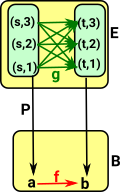 |
Can we take this further and treat P as a functor and map a function back along P-1 ? When we 'lift' f up to E we can't just assume that the function g will map corresponding elements:
fibrations can be more complicated and interesting than that. As shown the green arrows might go to any element. |
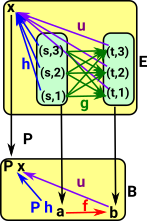 |
Following on from the example lets try to show the HEP in a more general form.
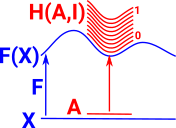 |
There are conditions to allow this. the arrows from A must play well with the map F. |
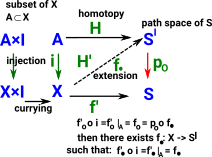 |
Mapping Cylinder and Mapping Cone
A sort of generalised test diagram.
Homotopy Extension Property (HEP)
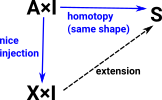 |
Given a homotopy of maps from A to S and an injection from A into a bigger space X (A is a subspace of X) |
|
Example for showing open sets mapping in the opposite direction. |
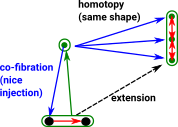 |
This is the inverse of the lift property.
For more about the extension property see the page here.
Extension as Dual to Lift.How can we get HEP by reversing the arrows in the diagram for fibrations (on the previous page)? Co-fibration involves the concept of extension
|
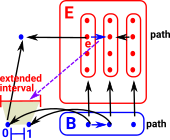 |
| If we have a path and part of that path is specified by an interval, how do we extend that interval? |  |
| When we inject A×I U X×0 into X×I we seem to be able to fill in the missing corner. | 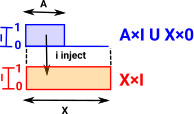 |
HEP in Simplicial Complex
A simplicial complex has the HEP with respect to any subcomplex. This allows homotopies to be constructed piece by piece.
simplicial complex is discussed on the page here. Each face (above dimension 0) will contain multiple sub-faces so this starts the look like a many:one relationship. |
 face maps |
 |
However, in a complex, faces can share the same boundary so there is a many:one relationship in the opposite direction. For instance, 'ab' is contained in both 'abc' and 'abd'. |
| So the relationship between say, a triangle and a line is a many:many relationship. This can be modeled like this: | 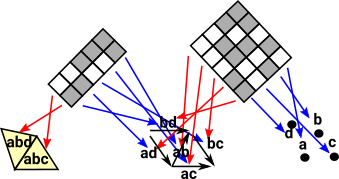 co fibre sequence |
So each of these maps is like a subset of a product.
This can be modeled using linear algebra (vector and matrix) although not quite in the usual way. Where the shapes are the vectors (just a list of subshapes) and the relationships between them are matrices. Say:
- 0 means subset relationship does not exist.
- 1 means subset relationship exists.
Next
- sheaves
- Fibrations and Cofibrations are used in model theory.
- Kan Extensions
Related Pages on this Site









